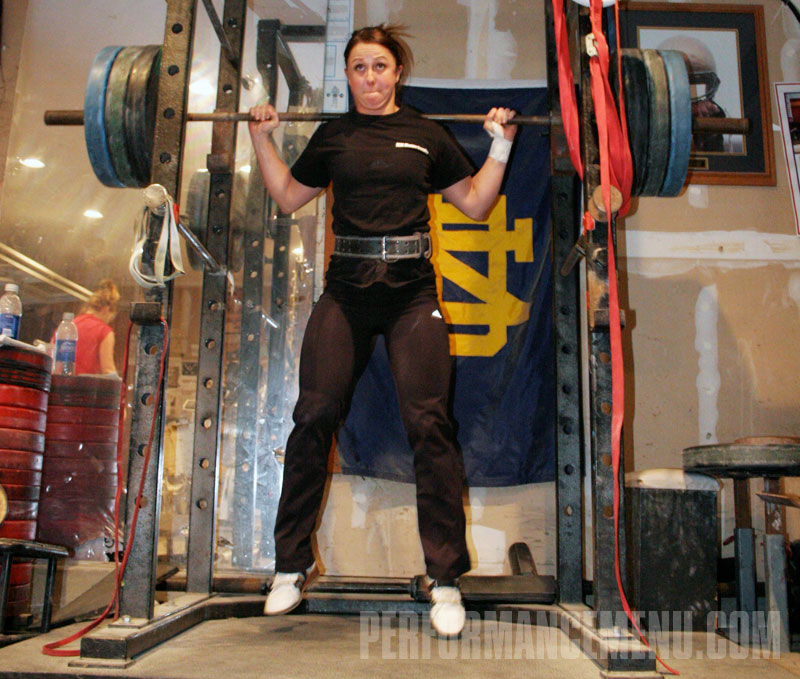Jumping Squat

The term jumping squat is used liberally to describe a number of different exercises. The one with which we're concerned here is performed from quarter depth under large loads. This allows us to greatly overload final leg and hip extension in order to improve the power of the jerk and the second pulls of the snatch and clean.
If you're concern is simply general AKP, a normal squat stance will work. If you're performing the exercise specifically for weightlifting, use your jerk or pulling stance.
Set the pins in a power rack to a height that stops you at a quarter squat. You can also use jerk boxes . Using a belt is wise considering the great loading and ballistic nature of the movement.
Typically jumping squats will be performed with the bar racked on the back. Position yourself under the bar and push the hips forward under the bar to assume the power position (the torso will need to lean forward somewhat because of the bar placement—don't try to get it perfectly vertical). Fill the stomach with air and jump as high as you can, trying to slow the bar's descent back down to the pins upon landing.
With serious loading, you won't come far off the ground, but drive like you're expecting to hit the ceiling. Make sure you're moving straight up. If you're not, your hips are not under the bar as they need to be.
If you’re feeling bold and indestructible, experiment with jumping front squats. Be sure to use a reliable power rack and a durable but cheap bar—I recommend dropping down under the bar as it returns to the pins instead of trying to control it. This is where the mythical jerk blocks can be very helpful.
Perform for 1-3 sets of 2-3 reps. Use as much weight as you can handle while remaining explosive. If you're feet remain stuck to the floor, drop the weight—this is a power movement, not a strength movement.
Video – Aimee Anaya Jumping Squat 160kg x 3
If you're concern is simply general AKP, a normal squat stance will work. If you're performing the exercise specifically for weightlifting, use your jerk or pulling stance.
Set the pins in a power rack to a height that stops you at a quarter squat. You can also use jerk boxes . Using a belt is wise considering the great loading and ballistic nature of the movement.
Typically jumping squats will be performed with the bar racked on the back. Position yourself under the bar and push the hips forward under the bar to assume the power position (the torso will need to lean forward somewhat because of the bar placement—don't try to get it perfectly vertical). Fill the stomach with air and jump as high as you can, trying to slow the bar's descent back down to the pins upon landing.
With serious loading, you won't come far off the ground, but drive like you're expecting to hit the ceiling. Make sure you're moving straight up. If you're not, your hips are not under the bar as they need to be.
If you’re feeling bold and indestructible, experiment with jumping front squats. Be sure to use a reliable power rack and a durable but cheap bar—I recommend dropping down under the bar as it returns to the pins instead of trying to control it. This is where the mythical jerk blocks can be very helpful.
Perform for 1-3 sets of 2-3 reps. Use as much weight as you can handle while remaining explosive. If you're feet remain stuck to the floor, drop the weight—this is a power movement, not a strength movement.
Video – Aimee Anaya Jumping Squat 160kg x 3
| Greg Everett is the owner of Catalyst Athletics, publisher of The Performance Menu Journal and author of Olympic Weightlifting: A Complete Guide for Athletes & Coaches, Olympic Weightlifting for Sports, and The Portable Greg Everett, and is the writer, director, producer, editor, etc of the independent documentary American Weightlifting. Follow him on Facebook here. |
Search Articles
Article Categories
Sort by Author
Sort by Issue & Date
Article Categories
Sort by Author
Sort by Issue & Date

